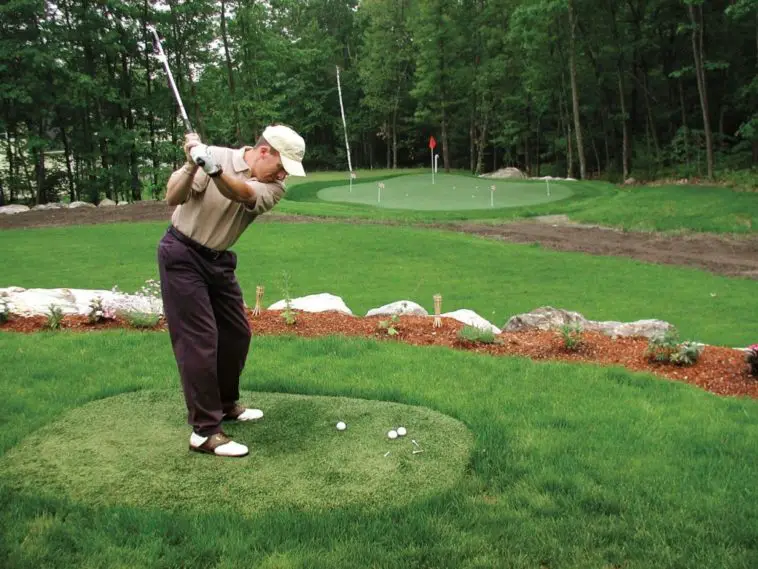An outdoor putting green makes honing your game as easy as walking out your back door.
Golf is a game that takes practice—and time. But what if there were a way to lower your score while spending more time with the family and increasing the value of your home?
There is: Install a backyard putting green. Today, most greens are made from nylon and polyethylene fibers, which produce a near facsimile to real grass. Many also eliminate the need for sand fill, which allows the putting greens to maintain longevity and consistent performance with little upkeep.
A leaf blower is about all you’ll need, says Doug Preston, owner of Southwest Greens of Boston. So if you have been looking for a way to get more practice in or a reason to invite the guys over, you have found green gold in this option. There’s more to a backyard putting green than even that, though!
Benefits of an At-Home Putting Green
There are plenty of reasons installing an at-home putting green could be on your following to-do list. However, these are the top 5 on the list.
1. More Time Around the Family
For those of us whose game is golf, we can understand the call of the pitch throughout the week into the weekend. However, it can become a fierce tug-of-war when that time is also available to spend with our families. Instead of worrying about which option you should choose, pick them both. By installing a backyard putting green, you get the best of both of those worlds and can even take the opportunity to practice with your kids.
2. Make Your Yard More Eco-Friendly
Most of the backyard greens installed nowadays are made from synthetic materials. These materials act on the ball the same way grass does but don’t require gallons of water that a grass lawn needs during the hot summer months. The more grass you replace with artificial putting green, the more eco-friendly your backyard is.
3. Cut Down on Backyard Maintenance
Just as it takes less water to keep a stand of grass growing strong, it also takes less personal maintenance on your part. Don’t worry about going out to mow the lawn when the lawn is a putting green made from artificial materials. Just keep in mind that if the putting green is only part of the lawn, place it in a convenient position to mow around without damaging anything. If you use any edging tools on your lawn, keep them away from the edge of an artificial green.
4. Improve Your Game
Perhaps one of the most obvious, and almost the most important, of the reasons is that having home access to a putting green likely means lower scores soon after. Practice makes perfect, as they say.
5. Enhance the Aesthetic Appeal and Property Value of Your Home
Finally, having a backyard putting green is seen as a luxury item. For many people, this will increase the allure of your home. By doing so, if it comes to selling the property, you will likely find the value of your home increased by adding a putting green in the backyard.
Grass vs. Turf
Now that you have been convinced that a backyard putting green is worth the investment, it is time to make some hard decisions. The first you will need to make is what material you want to use.
Although it might seem like natural grass would be the easiest option, it is the hardest to maintain over the long term. Most of today’s putting greens are fashioned out of synthetic turf. However, there still is a real grass feel. “You can actually hit shots into it, and the ball checks up just like a real putting surface,” Preston says.
Often, it comes down to when you are willing to invest time and money. For example, a grass putting green will require a less initial investment but will take much more over the months and years to come. On the other hand, a high-quality artificial putting green might seem expensive initially but will require almost no more input for the rest of its lifetime. You should also check with the company that sells or installs the green to ensure they have a warranty since an artificial green should last for many years.
DIY vs. Hiring a Landscape Designer
Whether you have chosen to opt for the grass or artificial putting green, you will now need to choose whether you will do it all yourself or hire a professional. Again, there is quite a range of choices when it comes to installation, pricing, product selection, and so much more.
If you decide you want to do it yourself, you can buy a synthetic green. Upon its arrival, follow the installation instructions carefully. If you want to do it right, be prepared for a day or two of hard work.
When working with a putting green designer, collaboration is essential to ensure results. That means staking out the area and measuring distances to ensure there’s enough room for chips and pitches, says Robert Pressman, a principal with TGP Inc. Landscape Architecture (tgpinc.net) in Encino, California. Pressman recently added a backyard putting green to his own home and recommends that greens be constructed in irregular shapes with elevations. “It allows for long and short putts and more difficult ones, too,” he says.
Doug Preston’s company in Boston charges around $17 per square foot laid down (backyard putting greens can range from 500 to 3,000 square feet, the latter about the size of a typical golf course green), also landscapes the periphery of the putting green with fringe, chipping areas, and even sand traps. Actual undulation is also incorporated into the green, making it a good putting experience. “A backyard green can turn a double-digit handicapper into a single-digit player; no problem,” Preston says.
Josh Powers owns Advanced Syntec in Santa Paula, California. Before digging out his clients’ yards, Powers brandishes a can of spray paint and, with the client, outlines the green—even X-ing out where the holes will go. “I actually have my clients putt on the dirt to help visualize it,” he says.
All this to say that when you decide to hire a landscape designer, or more specifically, a putting green designer, choose someone willing to customize it and work with your wants and needs. There might be certain aspects of the game you need to practice that you want to be reflected in your putting green. Make sure to communicate this early. Also, keep an eye out since some companies will only work with specific sizes and shapes. If you hire a professional, it is best if they are willing to customize something like this.
Design Considerations
A good design of a putting green doesn’t only incorporate some green turf and a hole or two. There are other design considerations you or your designer should be familiar with before beginning. First, drainage is essential for the continued functionality of the green.
Drainage is often a snap for artificial greens; most putting greens are built on porous bases, so water runs right through. “These greens are built to be used all year long, in any weather condition,” Preston says.
You should also consider any aspects of the game you need more practice with, whether you want something like a sandpit or even a small water feature included alongside the green. The placement of the holes is also essential. Is there a particular angle or gradient you struggle with? It is best to include all of these in the green.
Cost and Maintenance
The best part of getting an artificial putting green installed is the lack of maintenance. Invariably, most designers say that the best trait of an outdoor putting green is reducing its maintenance compared to a standard lawn.
Once the green is finished (companies can install most within a week), the only fundamental landscaping tools needed are a leaf blower and a broom. You can always go over it with a rake if you want to perk it up a bit after continued use. You should keep gasoline, oil and any other petroleum-based chemicals you can think of away from the surface of your turf. It won’t kill the grass like it will on a typical green, but the synthetic nature of the green can make it a dangerous combination.
On the other side of the coin, you have grass putting greens. You will need to keep it well-seeded, so the grass is thick and consistent throughout the green. Since grass is planted in soil instead of a draining base, you should pay special attention to maintaining the green’s drainage system.
Beyond these two aspects, mowing is likely going to be your most extensive duty during the growing season. Most putting greens are maintained at or below the height of 0.125-inch. Likely, this will be the lowest setting on your mower. When you are cutting the grass that short, you will need to water it daily when it doesn’t rain to keep it alive.
For some, the maintenance of their green is just as enjoyable as practicing on it. If you don’t believe you would fall into that category, it is likely best to opt for an artificial turf installation.





